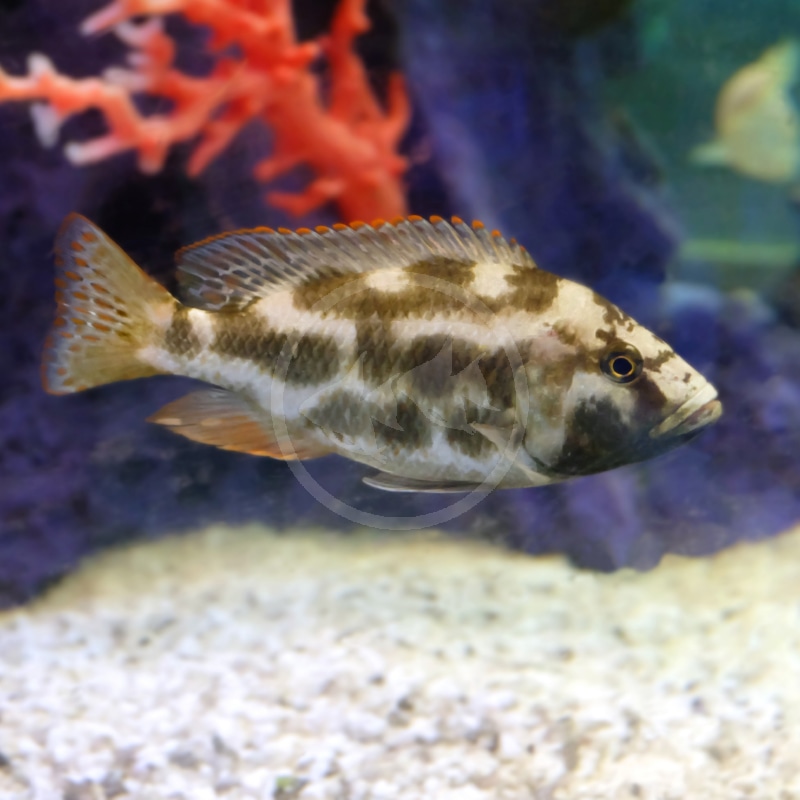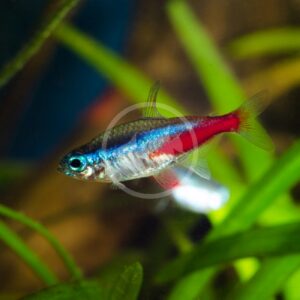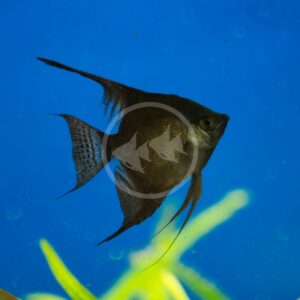Care Level: Easy
Temperament: Semi-Aggressive
Live Plant Safe: No
General Description: The Hap Livingstoni Cichlid is endemic throughout Lake Malawi in shallow waters of both rocky and soft substrates with beds of Vallisneria plants, though the majority of specimens within the aquarium trade are now commercially produced. Livingstoni was reclassified in 1989 as Nimbochromis rather than Haplochromis, or Hap, that is still commonly part of its description in the aquarium trade. Female or young male Livingstoni will have a silvery body with a dark brown blotchy pattern that also extends into its caudal (tail) fin. This patterning in the caudal fin helps to distinguish young Livingstoni cichlids from young Venustus cichlids (Nimbochromis venustus). Additionally, young Livingstoni have little to no yellow on them compared to young Venustus. An adult male Livingstoni can be extremely colorful, showcasing brilliant blues throughout the body; these colors may also intensify during spawning. Livingstoni are ambush predators in nature, and therefore may not be a fish for the community Malawi aquarium. In nature, Livingstoni have been observed to lay on their sides “playing dead”, which smaller fish will investigate and surely become a meal. This is truly a spectacular strategy to deceive prey. A solitary fish, Livingstoni (albiet males) can be quite aggressive toward each other, but are generally peaceful with species too big to be considered food. An adult Livingstoni can reach a size of approximately 10″.
Diet Requirements: Livingstoni, in nature, are piscivores but they do not require live fish in the aquarium to thrive. In fact, we discourage feeding live fish because they are often of little nutritional value and increase the risk of introducing disease. A diet made up of various high quality proteins are ideal, mainly frozen chunks of shrimp, silverside fish, and beef heart. Livingstoni will accept large sinking pellet foods and flake foods, but these should not make up a large portion of the diet. Variety is the spice of life in order to maintain color, immune function and longevity of your fish.
Care Requirements: An established minimum 75 gallon aquarium is ideal for Livingstoni. Biweekly water changes are encouraged to keep water parameters up to standard (Nitrates < 30 ppm). The aquarium should be aquascaped generously with stacked rocks to create many hiding spaces and caves, but some unobstructed and open swimming space should also be provided. A sandy or fine substrate is preferred and the aquarium needs to be well oxygenated. African cichlid specific substrates, or even marine Aragonite substrate, are great choices because they will buffer the pH and alkalinity to levels characteristic of Lake Malawi. Livingstoni are compatible with a number of Malawian and Tanganyikan fish, but should not be kept with overly pugnacious species, or species that can become a meal. Compatability among numerous Livingstoni becomes uncertain and variable as they reach sexual maturity. Recommended water conditions, 74-80° F, KH 10-25, pH 7.5-8.5.
Purchase Size: Medium: 2” to 3”
Note: Your item may not look identical to the image provided due to variation within species. Purchase sizes are approximate.












